
Du principe anthropique
à l'homme
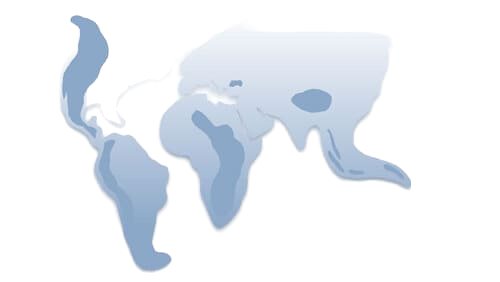


The first “deluge” had no witness when, 4,3 billion years ago, the temperature of the earth crust got under 100°C and the water vapour contained in the atmosphere started to condense, eventually forming the first oceans. Another “deluge” could have Homo sapiens as a witness, when around – 18 000 years and especially from – 10.500 years on, the climate progressively warmed (during the Holocene, which lasted from -10 000 to -5000 years, the temperature rose by more than 10 degrees), and when the deglaciation happened with a rise of the sea level of 120 meters. Thus, the entrance of the Cosquer cave (near Cassis), decorated with paintings and rock engravings which prove that it was occupied by Man, is presently immersed at a depth of 37 meters.

This “deluge” seems confirmed by two British geologists, William Ryan and Walter Pitman, who have discovered indications of a terrible flood in the sediments of the Black Sea, then a freshwater lake and separated from the Mediterranean Sea by the Bosporus, which would have occurred 8 300 years ago (1,2): As a rock barrier had broken, the Mediterranean rushed through a real canyon and invaded the plains situated at the other side. This event was actually the consequence of the rise of the sea level at the end of the last glaciation (Würm) 15 000 years ago. In order to understand the scale of the catastrophe, we must imagine the rupture of a giant dam liberating forces 400 times strongest than the ones generated by the Niagara Falls! “(Picture 1). A few tribes took refuge in the Taurus mountain range dominated in the East by Mount Ararat, then went down to settle in the plains of Mesopotamia. There, in the remains of the library of Nineveh (Picture 2) was found the story of the deluge (and even the description of the arch) inscribed in wedge shaped writing on the XIth tablet of the Epic of Gilgamesh. This epic dating from the third millennium BC, which the Hebrews could have taken from Abraham’s ancestors who were nomads in Mesopotamia about the same time, or which they could have learnt during their captivity (VIith century) or their deportation (VIth century) to Babylon, which probably inspired the biblical story of the Deluge.
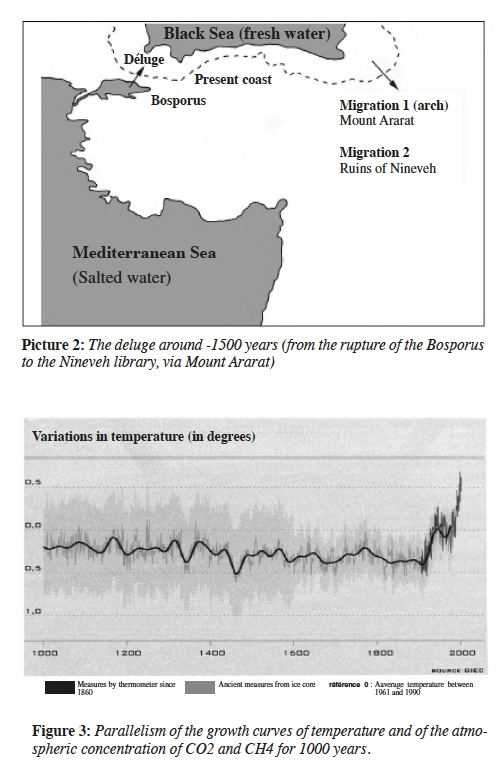
The historical deluge was situated and limited to a region which, at that time, represented a great part of the known world, and we can now imagine, and why not predict, a new deluge at the XXIth century, at the scale of the whole planet this time. For if the natural planet movement is at the output of the ce the massive breeding of ruminants started (and more recently the thawing of permafrost in the boreal zone) accelerates the current global warming: the paralleling of the curves of temperature evolution and of the atmospheric concentration of CO2 and CH4 for 1000 years (Figure 3) seems particularly convincing! And the forecast of planetary rejection of carbon dioxide report on a probable increasing of 62% between 1999 and 2020… Even if the curve of solar irradiance decoupled from the curve of the global temperature from 1980 on, as the temperature increased faster than irradiance. The intergovernmental Group of climate experts who met in Paris on February 2nd, 2007, predicts an average temperature rising up to 6,4 °C by 2010, which is definitely catastrophic. So, if the sea level has already raised of 120 meters during the last post glacial era then got fixed 6 000 years ago at its current level, giving us on the scale of human history a wrong impression of stability, it can still rise of 70 meters (+ 10 meters due to the expansion of the oceans) if the polar caps happened to melt entirely. Concerning the melting of arctic polar ice, it has fortunately no impact, since it already floats in the Arctic Ocean instead of resting out of water on a ground base.
If the Greenland ice cap entirely melted (Antarctic picture), the sea level would rise by about 7 meters. if the snow falls increase inside Greenland, the melting of the glaciers and their sliding towards the sea accelerate in a strip of 20 to 30 kilometres along the coasts where the satellite radar altimeter is not of a great help, but where the direct observation in the field and the great quantity of cracking registered by the seismographs are much more useful. We should pay more attention to the advice of the Eskimo populations and, if they could talk, of the starving polar bears hit hard by the moving of the food chain, rather than to the advice of some falsely reassuring, dangerously distant from the field climate scientists. Otherwise, a study led by Jianli Chen from the University of Texas (Science, August 11th, 2006) claims that the Greenland ice cap melts three times faster than during the five previous years and that it loses every year 240 cubic kilometres of ice (100 billion tons according to another study)!
If only the western part of the Antarctic melted (Picture Antarctic), the sea level would also rise by nearly 7 meters. Yet, for a few years, wide icebergs have been breaking from the west Antarctic Peninsula and we can notice the partial disintegration of the Larsen sea ice. The American Centre of data on snow and ice announced on March 19th, 2002 that a large part (3200 km²) of the Larsen B platform had collapsed from the Antarctic, and was supposed to drift towards Patagonia. This phenomenon would have occurred on March 7th, in a terrifying end-of-world crash. The same phenomenon happened on a smaller scale in August 2005 around Ellesmere Island, the most northerly of the Canadian Arctic archipelago, in which a 66 km² ice shelf has come loose and would drift towards Alaska. The scientists now fear that blocks of ice should slide from the island into the ocean. Concerning the Ross pack ice, it decreases by 100 meters every year (3). This is particularly worrying as we know that the Antarctic ice sheet has not melted (or only a little) during interglacial periods, and it gives us a strong clue of the specificity of human activity.
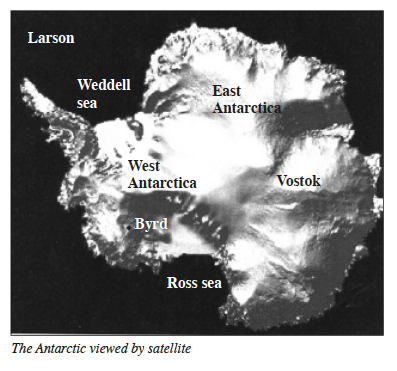
The action of Men could be dramatically accelerated if the Earth “decided” to make the Erebus volcano erupt on Ross Island (in constant activity since 1972), as well as the four other active volcanoes of the white continent. We must not forget that Erebus is Chaos’s son in Greek mythology, and that, even if it was the name of Sir James Ross’s ship, I believe that nothing happens by chance, that everything has an unconscious signification and, in that very case, a warning value. The fact that the permanent lava lake of the Erebus, one of the only three in the world, is particularly rich in gold, could one day cause a gold rush similar to the Klondike (Canada) rush in 1896, in spite of still more adverse conditions and of a treaty which still forbids (but for how long?) the exploitation of mining resources on the white continent. In any case, the ice melting could turn to the debacle in the whole west of the Antarctic continent, and the damage would not be limited to the simple lack of krill in the ocean and to the disappearance, as we can currently see in Adelie land, of half the couples of emperor penguins, whose winter nutrition is composed of these little shrimps. It would be infinitely more serious, more violent, and more cataclysmic (in the sense of kataklysmos, the “deluge” of the Greek mythology), and even the human species would be partly threatened.
We’ll add, for good measure, that:
Only a decrease of the temperature and of the salinity (caused by the melting of the arctic ice) of the Gulf Stream could allow Western Europe to partly avoid global warming.
Thus we can easily imagine, in front of so many worrying signs, the imminence of a new deluge (progressive or worse, in the form of a sudden collapse), and advise the populations of the lowest coasts in the world, from the famous polders in Holland to Bangladesh, as well as Camargue (Aigues-Mortes and its silted-up port could one day be renamed “Aigues-Vives”), the Louisiana bayous, the Maldivian atolls, Marshall islands, the Nile delta and Veneto, to prepare their “Arks” in order to deal with cataclysmic floods! In Venice, for example, the periods of “aqua alta” (high waters) have already gone from once to forty times a year, and the city is getting ready to have one day definitively its feet in water, if global warming goes on. Such a marine transgression – with the seas going up the valleys – due to the melting of the ice sheet has already happened during the interglacial era separating the Riss from the Würm, that is, between -130000 and -100000 years. Its consequences over human civilization and population would be far more serious now. The Franco-American satellite Topex-Poseidon launched in 1992 and relayed by satellite Jason (then Jason-2 from 2008 on) has already measured, thanks to its radar altimeter, an increase of the average level of the sea (which has already gone up from 10 to 25 cm according to the measures during the XXth century) of 2 mm a year, 4 mm in western Mediterranean and even 2 cm in Eastern Mediterranean (caused by expansion due to water temperature). A simple projection shows that at this rate water would rise by 40 cm during the XXIth century in western Mediterranean. Thus the curve is not linear, (Picture 4), which leads us to predict the worse…
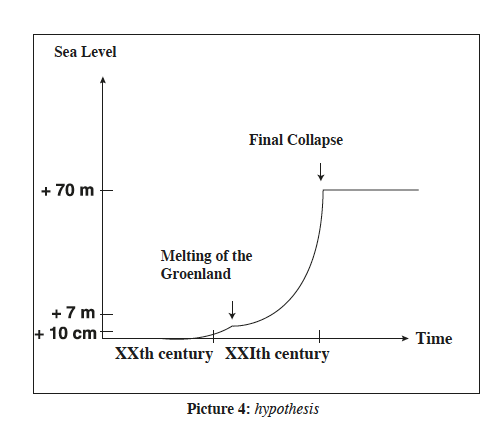
To understand the anthropic meaning of these past or upcoming events, we have to go back and know that a weather event, unusual as far as the history of life on earth is concerned, gave a providential “helping hand” to the long ascension of the evolution towards human species and to its expansion in the animal kingdom: it is the Pleistocene glaciation (first era of the Quaternary period). “Few people realize that we are living an exceptional time in the history of Earth” explains Philippe Janvier (4). “For about 16 million years, our environment has gone through a series of ice ages, separated by warmer interglacial periods, like the present era. Such a phenomenon only happened twice during the last 550 millions of years: 430 and 300 million years ago”. In other words, the climate on earth had been tropical and temperate since the explosion of reptilian forms (270 million years) that is, since the conquest of continents (at that time a unique continent: the Pangaea). In animal memory, there had never been any ice age before the Quaternary period, the era of the explosion of human forms! By the way, we can find fossils of dinosaurs (polykilothermic animals) in Antarctica, which shows that in the Cretaceous period the Austral continent was ice free. The Parisian palaeontologist adds: “The main victims of the Quaternary crisis were the great animals, particularly the great mammals. Just before the first Quaternary ice age, there were probably more species of great terrestrial mammals (…) than species of dinosaurs at the eve of the Tertiary-Cretaceous crisis.”
In short, the Quaternary sees the extinction of the giant mammals (mammoths, mastodons, woolly rhinoceroses, cave bears and lions, sabre-toothed tigers, aurochs, megaloceros deers), as well as the tertiary sees the extinction of the giant reptiles at the very moment when the Primates appear on Earth (Table 1) Only the giant sea mammals (the blue whale with its 35 metres and 150 tons, the weight of 33 elephants, is the biggest animal that the planet has ever supported), whose biotope prevented them from coming into conflict with Hominids, and the giant African mammals (elephant, rhinoceros) which at their latitude did not endure the effects of ice age, will avoid extinction. The east-west disposition of the European and Asian reliefs also played a role by being an obstacle to the North-South migrations of these great animals, which got trapped in the North covered with ice. On the contrary, the North-South disposition of the American relief would allow a few giant species to survive better (grizzly, buffalo, moose), but that continent was never occupied by Hominids, and modern Man only migrated there at a very late stage.

Thus, the exceptional ice ages of the Pleistocene are as providential for the Homo species, whose adaptation was facilitated by his emerging technology (the invention of fire dates back around 450 000 years) as the Yucatan asteroid was for the class of mammals, whose adaptation was facilitated by homoeothermic and placental reproduction. This climatic trial imposed on Homo species freed him from the last predators or monstrous opponents which still threatened him, and opened the way to his fast development in all the ecological niches of the emerged world. We see that only the surviving giant species of the animal world are sea species, which do not compete with Man: octopus or giant squid for the invertebrates, whale and cachalot for the vertebrates. It is important to notice that the domestication of fire marks the end of the massive predating skills of animals towards Man, and that the discovery of nuclear fire will mark the end of the massive interhuman predation. Anyway, the probability of an exceptional ice age in the History of Earth coinciding with a critical step of development of the Homo species was tiny.
We will also observe this very particular geographical configuration, which cannot be fortuitous because it is so providential, which allows the Earth, beyond astronomical explanations (which only explain periodical variations) by opening and closing according to plate tectonics thin ground plates (Panama and Suez isthmus, Gibraltar and Behring straits) to modify massively the climate (like triggering an ice age) by simply modifying the ocean circulation. So a tropical climate could have still remained for tens of millions years, postponing as long the Holocene era, that is to say the unchallenged domination of Man on Earth. This final perspective even leads us to predict that the era we are now living is not an interglacial era, but a post glacial era, since the Earth would not have any interest in maintaining a selection pressure through a “glacial stress” whose objectives are now achieved. The Deluge with a rise in the water levels of 120 metres and the breaking of the Bosporus 8 300 years ago was the first manifestation, the great meltdown which is coming up (accelerated by the greenhouse effect) with a new rising of waters of 80 metres from the XXIth century on should be the final manifestation. In fact, we should have been in the Quinternary (or Quaternary II) since the Holocene (12 000 years), and still more since the “Anthropocene” (200 years)!
A physiological clue predicts that the Holocene or its by-product the Anthropocene could last much longer than the Pleistocene, after a post cataclysmic stabilization phase, since Man’s real circadian rhythm (sleep/wake alternation, internal biological clock) has an endogenous periodicity of 24,18 hours (5), independent of the day/night alternation (24 hours). As we know that the day is getting longer of 0,002 second per century (6), Man is therefore curiously set today, in spite of natural selection, for a day which will not exist before 32,4 million years. Till then, the solar light plays the role of external synchronizer with his brain relay, melatonin, whose production by the epiphysis is stimulated when the activity of the optic chiasm diminishes with the vesper decrease of luminosity and triggers the phase of preparing to sleep. We should add that today this external regulation is often desynchronized by artificial light, and even by air flights crossing several time zones. The estimated settings of biological evolution then seem to anticipate a second phase of the Quaternary which would last for nearly 65 million years, which is equal to the duration of the Tertiary, since the external synchronizer should be symmetrically efficient up to a day of 24,36 hours. The surface of emerged lands will return to the small portion (usual on Earth) and the climate would be subtropical where it used to be temperate, the Antarctic free of ice becoming the only temperate continent in the globe. Adélie Land in the Antarctic will then have become the favourite summer residence of the French and the new Dumont d’Urville station (the old station will have been engulfed by waters in the IIIrd millennium), a very popular resort. After crossing the coastal meadows, the sportsmen will be able to ski in the last ski resorts of the emerged land…
The coming great debacle in the post glacial era where we are today and under the huge “greenhouse” generated by human activity will have, because of the sudden rise of waters, economic, social and political consequences of exceptional magnitude. There too, the anthropic principle and the consultation of political archives of the XXth century make us predict a time of great social unrest, which, like recently, should be resolved in the establishment of a totalitarian political order. Actually, the restriction of emerged land associated to the flow of millions of refugees and to the destruction of the coastal industrial base and of the cultivated plains will result in the de-formalization of society, which at first, and in the general unpreparedness can only be fought by exceptional political systems. The fascist parties and the communist party will compete on the control of this overpopulated and starving society, which the traditional democratic parties will not be able to manage. At the level of religious communities, the Protestant Christian communities, better organized, more supportive and also more austere, and, as a consequence, better prepared to food restrictions, should protect their members better than some other more glorious churches, who are readier to share abundance than scarcity.
The Earth seen from the sky will look like a large natural concentration camp, where the barbed wire will be replaced by the foaming waves, surrounding what will remain of emerged land (the Blue Planet will carry its name still better). A movie by Kevin Reynolds (Waterworld) talked about this prospect in 1994, and exaggerated it to the extreme: Around the year 2500, the Earth is nothing but a huge ocean and Men, who survive on artificial atolls, dream of joining one day the firm land, the mythical Dryland which, as they say, is not covered by water… This scenario could only become possible if erosion ironed out all the reliefs of Earth: The liquid water would form a 3 kilometres thick blue layer spread all over the Earth. But let us come back to a closer future: in France, Lyons (160 m.) will be again the capital of Gauls (reduced version) since Paris, 29 metres high, and Marseilles will henceforth be under water (Picture 5). Like in a concentration camp, hunger, provoked by the restriction of farm land, the low-yielding of mountain farming (50 quintals per hectare compared to 200 in plains) and the major climate modifications (disappearance of Gulf Stream, monsoon regime in Europe with floods in winter and droughts in summer, general increase of evaporation and moisture, disappearance of snow and of the last glaciers) will cause the return to barbaric animality, and the war of extermination will be considered as a possible recourse to overpopulation, and to resolve the conflicts of the rival totalitarianisms. This situation should then improve after the necessary historical adjustments, and lead to a long period of stabilization in a tropical to temperate climate ((that is, where it used to be temperate to cold).
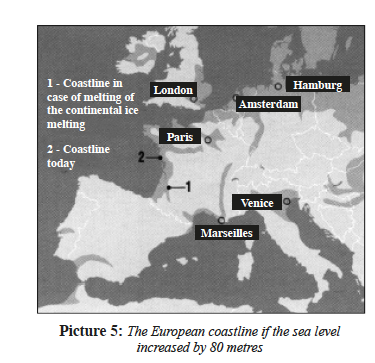
Actually, the only means to save what can still be saved would be to carry out, in the Dutch way, a gigantic Mediterranean polder requiring three Herculean works: reclose the Gibraltar strait and the Bosporus, which used to be closed (five million years ago for the first, 8 300 years for the second), and close the Suez Canal. This project would allow, by maintaining the level of the Mediterranean Sea at its present level, to preserve the great port cities (Marseilles), or historical (Venice) and additionally to protect the salines of Salin-de-Giraud, which nonetheless produce 95% of the French sea salt. However oceanic water releases should regularly be undertaken, or the Mediterranean Sea would rapidly dry up, for the flow of great rivers into the sea does not make up for evaporation of this stretch of water. It can be demonstrated with the “gorges du Var”, in France, which extend very far under the sea, reminding that when it was still closed (- 5 million years), its level was much lower than today. But, on the contrary, it would have the advantage of making possible the production of electricity through the waterfall which would exist. We can even consider the presence of locks, on such an imposing construction, allowing the passage of ships from the ocean to the sea (lower) and vice versa, and even the passage of a railway line linking the Spanish high-speed train to the future Moroccan high-speed train. Or still more ambitious, add to this project a middle-eastern project preserving the petroleum resources (its over-exploitation is the cause of the problem, hence a certain paradox) and close the Ormuz strait to protect the Persian Gulf from the waters of the Indian Ocean. Still, on the one hand, human technology must be able to fill so important geological faults and to build so enormous dams in the sea environment, on the other hand, the political willingness and foresight must be present when it is still time! The Gibraltar dam will of course cost a lot, but if it is not made it would cost much more. Concerning the maritime traffic, it will hardly be disturbed by the closing of the Mediterranean Sea, because of the locks, but especially because by 2030 it will have been diverted towards the “North-West route”, opened in 1879 by the Swedish Nordenskjöld, which provides a passage at the North of Russia already relatively clear of ice in Summer, towards the Bering Strait and then towards the East coast of Asia or the West coast of North America. To the speed at which the ice cap of the Arctic Ocean melts, this way should be feasible all year long without the help of ice-breakers around 2030. It provides so great economic advantages (5000 km less between London and Yokohama, no waiting in front of the Canal, no right-of-way) that the Suez Canal will be condemned and Egypt will become a stricken country, but where the lower valley of the Nile will not risk being submerged thanks to the project of Mediterranean polder.

In this context, we can wonder if the European construction, eventually threatened by a marine transgression, should not counteract this predictable geo-climatic deadlock by a closer cooperation with the other Mediterranean countries: Balkans, Maghreb, Machreq and Middle East. This presents many difficulties on a cultural level, since this will mean ensuring the coexistence of the three monotheist religions in a geopolitical entity, but this will be the only means to escape the devastating effects of the rising of the ocean level. In exchange for the technological and financial investments of the European community, these countries could commit to welcome and assimilate quotas of north-European populations when they are affected by the rising waters. This amounts to invent the notion of climatic asylum or climatic refugees, preferable to great barbaric invasions which already had devastated the Roman Empire, that is to say the periphery of the Mediterranean basin, in the IVth and Vth centuries of our era, but this time under the pressure of a glaciation. Such a cooperation would in any case be preferable to the predictable results of the efforts of military and especially nuclear training by countries like the United States and France, which, through the development and manufacturing of more or less clean tactical nuclear weapons, called “battlefield” with radio-active fallout of limited duration (around fifty years), even of no fallout at all (neutron bomb), discreetly prepare an invasion war aiming at the massive elimination of populations living on lands coveted for their relief. This strategic perspective may explain the eagerness of some countries, even not European, to integrate the European community, and inversely the determination of some countries like Iran to develop the nuclear weapon and essential vehicles, before the Russian plains are about to be flooded.